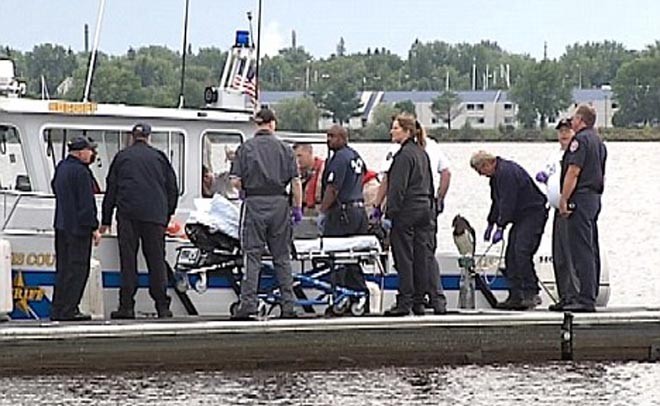Nine-year-old killed by lightning strike on sailing boat - 10 Tips
by Sail-World Cruising round-up on 20 Aug 2012

Lightning strike rescue in progress SW
A nine-year-old boy has been killed by a lightning strike on a 26ft sailing boat during a pleasure sail, while seven others were injured. The tragic incident occurred on Lake Superior in the USA when a storm forced them to take refuge in a bay on the Lake, near the end of Minnesota Point.
The incident occurred at about 5.30pm on Saturday according to a news release from the St. Louis County Sheriff's Office. The alarm was sounded by one crew member calling 911.
Assistant Fire Chief Jarry Keppers told the Duluth News Tribune the nine-year-old boy was found face-down in the water by his brother, who turned him over. It is believed that the sailors were trying to reach shore when the lightning storm struck but did not have time to do so.
He said the other people on the sailing boat started CPR, which was continued by rescue workers who got a pulse back.
The site where the group took refuge was difficult to get to, the fire chief said, but law enforcement and rescue agencies rushed to the site by boat and ATV.
The nine -year-old boy from Iron River, Wisconsin, was flown to a hospital in Duluth, where he was pronounced dead. His name was not immediately released.
Four others were taken to Duluth hospitals with what authorities described as severe but not life-threatening injuries.
Duluth fire officials said on Saturday that everyone had some injuries and the group included parents and their two boys, grandparents and a couple who were friends of the family.
Because of the difficulty in getting to the site, Keppers, said, about 25 minutes elapsed before the first firefighters arrived by boat. Other responders followed by boat, ATV and on foot.
Except for the nine-year-old, all were taken by boat to Sky Harbor Airport or the Duluth Coast Guard Station, both of which are on Minnesota Point, a sand spit that juts about 7 miles into Lake Superior. From there, they were driven in ambulances to hospitals, Keppers said.
.................................................
This tragedy is a reminder to all of us who sail. What should you do if you are sailing and a lightning storm approaches? - Here are ten tips:
1• Don't wait until it's too late: If practicable, get off the water early. If you're in a fast boat and can't get in, you may be able to get around the storm.
2• Inside is best: If you can't get off the water in time, the best place to be on a boat is inside any cabin, but avoid being near mast or chainplates, or large metal appliances like refrigerators.
3• Disconnect the power and antenna leads to your electronics: Many strikes just damage electronics so disconnecting them goes a long way in preventing equipment damage.
4• Keep away from metal: If there is no 'down below' and you're stuck out on deck, stay away from metal railings, wheels, the mast and mast stays, or any other metal fittings. There is record of a boater being killed in North Carolina when lightning jumped from his sailboat's backstay to his head and then the metal steering wheel he was holding.
5• Don't be a lightning rod: If you're on an open boat, stay low and in the center. Depending on the severity of your situation, it's also a good idea to remove jewelry. There was a case reported a few years ago in which lightning struck a man who was standing up wearing a large medallion.
6• Stay out of the water: Don't fish during a thunderstorm - or dangle toes overboard.
7• Lower antenna: Unless they serve as part of a lightning protection system, lower any antennas.
8• Stay silent: Don't use the VHF unless absolutely necessary.
9• Lightning grounding protection systems: Grounding systems, which provide a path for the lightning to enter and safely exit the boat, must be free of corrosion if they are going to provide any protection.
10• Dissipater dilemma: As for mast-top lightning dissipaters, there is no agreement by the experts on how well or if they work at all. It should be noted that insurance claims files show that boats with 'brush-like' dissipaters mounted at the top of the mast have been struck by lightning.
(However, many cruising sailors who have experienced severe lightning strikes report that lightning protection does not work at all against a severe strike which can melt most metal on the boat)
Finally, if you do get hit:
1) Check people first
2) Then check the bilge as strikes can rupture through-hull fittings and punch holes in hulls
3) Check electronics and compass
4) You may want to consider a short haul to check the bottom thoroughly (trailerboats can be inspected when you get back home). The challenge with lightning strikes is that they sometimes leave hard to find traces of damage that may only be seen when the boat is out of the water.
If you want to link to this article then please use this URL: www.sail-world.com/101128